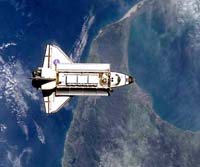Astronauts find no damage to space shuttle Discovery after launch
Space shuttle Discovery's heat shield looks to be in good health so far, NASA managers said, although it will be at least two days before engineers can rule out any possible damage from the program's first night launch in four years.

"So far so good," said lead flight director Tony Ceccacci on Sunday as Discovery's astronauts wrapped up a meticulous inspection of the shuttle, looking for any possible damage from liftoff.
As expected, small pieces of foam debris and ice fell off Discovery's external fuel tank during Saturday night's launch, but they didn't appear to strike the shuttle, said deputy shuttle program manager John Shannon, chairman of the mission management team.
Because Discovery was launched in the dark, NASA technicians were not able to capture the same sharp photos as they did during last three shuttle launches. Still, they were able to take better than expected images from the illumination of the shuttle's solid rocket boosters and engines during the first few minutes of flight. They also relied on radar, although one out of the three radars failed during the launch.
NASA may have to wait an extra day to look at images taken from the solid rocket boosters. An accident on one of the two ships used in recovering the boosters from the ocean postponed the retrieval by more than a day.
"The team sees nothing of concern at this time," Shannon said.
NASA engineers were studying four low-momentum readings from sensors on the leading edge of the shuttle's wing about two minutes after liftoff.
"I don't know if they're strikes. In the past, there's a lot of folks who think it's just a shock wave passing over ... or there's some settling," Shannon said. "We've seen exactly the same thing on the last couple of flights. We don't know exactly what's happening."
The thorough sweep of the shuttle included the wings and nose cap for chips and other damage from foam, a procedure made mandatory after the deadly Columbia accident in 2003, reports AP.
Engineers were working on problems with a system that cools the shuttle's radiators, a predicament that surfaced during Discovery's last flight in July. They also worked on a latching mechanism on the shuttle's robotic arm that would not operate automatically. Neither was expected to affect the flight.
During tests late Saturday, astronaut Nicholas Patrick manually ordered the arm to grasp the boom. Otherwise, the inspection was without incident. Engineers are examining the camera images in real time and also will review them in greater detail later on.
Meanwhile, the other crew members checked on the spacesuits that will be used during the mission's three spacewalks.
Discovery fired its engines Sunday to raise its altitude to 216 miles (348 kilometers) above Earth, nearly level with the international space station, where it will dock Monday afternoon.
Then the real work begins.
The first spacewalk on the 12-day mission will involve installing an $11 million (Ђ8.3 million) addition to the space lab, while the second and third will be for rewiring the station from its temporary power system to the permanent one. The solar power arrays that were brought up during the last mission will be used for the first time after that reconfiguration is complete.
Discovery's crew will bring home one of the space station's three crew members, German astronaut Thomas Reiter of the European Space Agency. American astronaut Sunita "Suni" Williams will replace him, staying for six months.
Subscribe to Pravda.Ru Telegram channel, Facebook, RSS!




